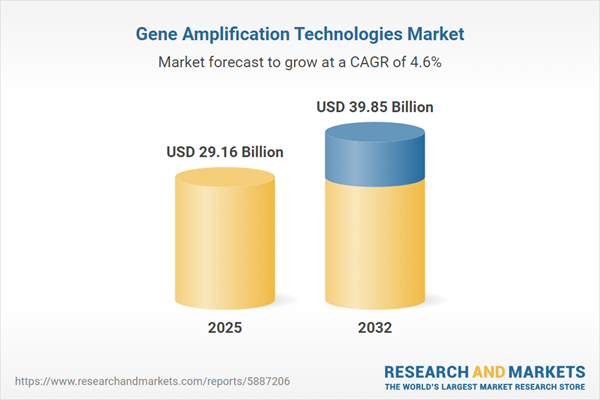Speak directly to the analyst to clarify any post sales queries you may have.
Gene amplification technologies are rapidly redefining the landscape of molecular diagnostics, research, and biotechnology. Decision-makers require a clear understanding of the evolving market, shifting value propositions, and the critical trends driving adoption across global healthcare and scientific domains.
Market Snapshot for Gene Amplification Technologies Market
The Gene Amplification Technologies Market grew from USD 27.91 billion in 2024 to USD 29.16 billion in 2025. It is projected to continue expanding at a Compound Annual Growth Rate (CAGR) of 4.55%, ultimately reaching USD 39.85 billion by 2032.
Scope & Segmentation of the Gene Amplification Technologies Market
This report provides comprehensive coverage of the gene amplification market, offering in-depth analysis across product types, technology platforms, end users, and applications. Major regional markets and significant industry players are also addressed.
- Product Type: Instruments, consumables & reagents (including enzymes, kits), software & services (with analysis software, custom services)
- Technology Type: Digital PCR, isothermal amplification (helicase-dependent amplification, loop-mediated amplification, recombinase polymerase amplification), conventional PCR, quantitative PCR
- End User: Academic institutions, diagnostic laboratories, hospitals & clinics, pharmaceutical companies (including big pharma, biotech firms), research institutes
- Application: Agricultural testing, drug discovery & development, environmental testing, medical diagnostics (genetic disorders, infectious diseases, oncology), research (epigenetics, genomics, transcriptomics)
- Regional Coverage: Americas (United States, Canada, Mexico, Brazil, Argentina, Chile, Colombia, Peru), Europe (United Kingdom, Germany, France, Russia, Italy, Spain, Netherlands, Sweden, Poland, Switzerland), Middle East (UAE, Saudi Arabia, Qatar, Turkey, Israel), Africa (South Africa, Nigeria, Egypt, Kenya), Asia-Pacific (China, India, Japan, Australia, South Korea, Indonesia, Thailand, Malaysia, Singapore, Taiwan)
- Companies Analyzed: Thermo Fisher Scientific Inc., F. Hoffmann-La Roche Ltd., QIAGEN N.V., Danaher Corporation, Bio-Rad Laboratories, Inc., Agilent Technologies, Inc., Merck KGaA, Promega Corporation, Takara Bio Inc., New England Biolabs, Inc.
Key Takeaways: Strategic Insights into the Gene Amplification Technologies Market
- Technological advances have diversified gene amplification, enabling higher sensitivity and more streamlined workflows across both centralized and decentralized testing environments.
- Automation, miniaturization, and cloud-based data integration are transforming laboratory processes, allowing rapid analysis and supporting dynamic, collaborative research models.
- Organizations across varied sectors—including diagnostics, healthcare, and agriculture—are leveraging these advancements to accelerate decision-making and improve outcomes.
- Cross-sector partnerships are fueling the development of unified standards, facilitating regulatory navigation and broadening the market’s application scope.
- The rise of digital and isothermal methods has increased accessibility, particularly in resource-limited settings, aiding broader public health goals.
- Software integration and machine learning are refining result interpretation, enhancing the value proposition for end users and supporting market differentiation among providers.
Tariff Impact: Navigating Supply Chain Complexity in the U.S.
The introduction of new tariffs on imported gene amplification components in the United States in 2025 has complicated sourcing and procurement strategies. Companies have responded by prioritizing domestic partnerships, exploring modular product designs, and reinforcing inventory management to reduce risk and maintain business continuity during geopolitical fluctuations. These measures are supporting long-term operational resilience for stakeholders across the value chain.
Research Methodology & Data Sources
This report utilizes a blended methodology, combining secondary research from peer-reviewed journals, regulatory databases, and corporate disclosures with primary research through structured interviews with industry experts. Data triangulation and both quantitative and qualitative analysis ensure rigor and accuracy throughout the assessment.
Why This Report Matters
- Enables senior leaders to benchmark strategies against emerging global, regional, and sector-specific trends for the gene amplification technologies market.
- Offers actionable intelligence on supply chain resilience and partnership opportunities to secure competitive positioning amid regulatory shifts.
- Delivers critical insights on technology diversification and adoption dynamics to inform capital allocation or portfolio management decisions.
Conclusion
The Gene Amplification Technologies Market continues to evolve, shaped by technology innovation and shifting global trade dynamics. Senior decision-makers equipped with this intelligence will be better positioned to drive value, resilience, and sustainable growth for their organizations.
Additional Product Information:
- Purchase of this report includes 1 year online access with quarterly updates.
- This report can be updated on request. Please contact our Customer Experience team using the Ask a Question widget on our website.
Table of Contents
3. Executive Summary
4. Market Overview
7. Cumulative Impact of Artificial Intelligence 2025
Companies Mentioned
The companies profiled in this Gene Amplification Technologies market report include:- Thermo Fisher Scientific Inc.
- F. Hoffmann-La Roche Ltd.
- QIAGEN N.V.
- Danaher Corporation
- Bio-Rad Laboratories, Inc.
- Agilent Technologies, Inc.
- Merck KGaA
- Promega Corporation
- Takara Bio Inc.
- New England Biolabs, Inc.
Table Information
| Report Attribute | Details |
|---|---|
| No. of Pages | 187 |
| Published | October 2025 |
| Forecast Period | 2025 - 2032 |
| Estimated Market Value ( USD | $ 29.16 Billion |
| Forecasted Market Value ( USD | $ 39.85 Billion |
| Compound Annual Growth Rate | 4.5% |
| Regions Covered | Global |
| No. of Companies Mentioned | 11 |









